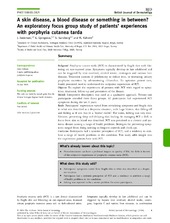A skin disease, a blood disease or something in between? An exploratory focus group study of patients' experiences with porphyria cutanea tarda
Peer reviewed, Journal article
Published version
Permanent lenke
https://hdl.handle.net/1956/9015Utgivelsesdato
2014-11-27Metadata
Vis full innførselSamlinger
Originalversjon
https://doi.org/10.1111/bjd.13198Sammendrag
Background Porphyria cutanea tarda (PCT) is characterized by fragile skin with blistering on sun-exposed areas. Symptoms typically develop in late adulthood and can be triggered by iron overload, alcohol intake, oestrogens and various liver diseases. Treatment consists of phlebotomy to reduce iron, or increasing urinary porphyrin excretion by administering chlorochin. To optimize patient care, health personnel need to understand the subjective experiences of PCT. Objectives To explore the experiences of persons with PCT with regard to symptoms, treatment, follow-up and prevention of the disease. Methods Interpretive description was used as a qualitative approach. Twenty-one participants attended three focus groups. All participants had experienced PCT symptoms during the last 5 years. Results Participants' experiences varied from trivializing symptoms and fragile skin to what was described as a desperate situation, with huge blisters, skin falling off and feeling as if one was in a ‘horror movie’. For some, itching was very troublesome, preventing sleep and delaying skin healing. In managing PCT a shift in focus from skin to blood was described. PCT was perceived as a chronic and systemic disease causing a range of health problems. Strategies for preventing symptoms ranged from doing nothing to frequent controls and check-ups. Conclusions Participants had a systemic perception of PCT, and a tendency to attribute a range of health problems to the condition. This study adds insight into the experiences patients have with PCT.

